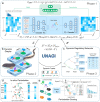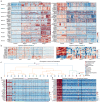This is a preprint.
Unagi: Deep Generative Model for Deciphering Cellular Dynamics and In-Silico Drug Discovery in Complex Diseases
- PMID: 38196613
- PMCID: PMC10775382
- DOI: 10.21203/rs.3.rs-3676579/v1
Unagi: Deep Generative Model for Deciphering Cellular Dynamics and In-Silico Drug Discovery in Complex Diseases
Update in
-
A deep generative model for deciphering cellular dynamics and in silico drug discovery in complex diseases.Nat Biomed Eng. 2025 Jun 20. doi: 10.1038/s41551-025-01423-7. Online ahead of print. Nat Biomed Eng. 2025. PMID: 40542107
Abstract
Human diseases are characterized by intricate cellular dynamics. Single-cell sequencing provides critical insights, yet a persistent gap remains in computational tools for detailed disease progression analysis and targeted in-silico drug interventions. Here, we introduce UNAGI, a deep generative neural network tailored to analyze time-series single-cell transcriptomic data. This tool captures the complex cellular dynamics underlying disease progression, enhancing drug perturbation modeling and discovery. When applied to a dataset from patients with Idiopathic Pulmonary Fibrosis (IPF), UNAGI learns disease-informed cell embeddings that sharpen our understanding of disease progression, leading to the identification of potential therapeutic drug candidates. Validation via proteomics reveals the accuracy of UNAGI's cellular dynamics analyses, and the use of the Fibrotic Cocktail treated human Precision-cut Lung Slices confirms UNAGI's predictions that Nifedipine, an antihypertensive drug, may have antifibrotic effects on human tissues. UNAGI's versatility extends to other diseases, including a COVID dataset, demonstrating adaptability and confirming its broader applicability in decoding complex cellular dynamics beyond IPF, amplifying its utility in the quest for therapeutic solutions across diverse pathological landscapes.
Conflict of interest statement
NK is a scientific founder at Thyron, served as a consultant to Boehringer Ingelheim, Pliant, Astra Zeneca, RohBar, Veracyte, Augmanity, CSL Behring, Splisense, Galapagos, Fibrogen, GSK, Merck and Thyron over the last 3 years, reports Equity in Pliant and Thyron, and grants from Veracyte, Boehringer Ingelheim, BMS and non-financial support from Astra Zeneca.
Figures








References
Publication types
Grants and funding
LinkOut - more resources
Full Text Sources
Miscellaneous

